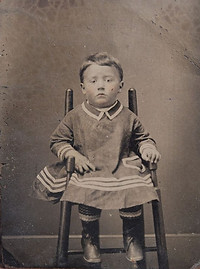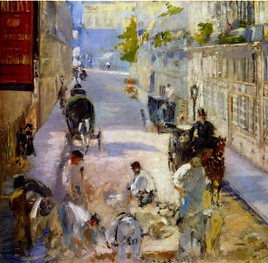Roger James Magee Marriage no.2
Well it seems that, like most young men in his position, he remarried. And pretty quickly too. In October of the same year, the 19th to be exact, he married Ann Berry, spinster and milliner - a young lady slightly older than Roger himself from Kent. She had been baptised in a Wesleyan chapel but she and Roger were married in the Catholic Chapel of St John Maddermarket where Roger had been baptised 31 years before. It was to be a long marriage - over fifty years, so let us hope that it was a happy one, though heaven knows it must have been one fraught with difficulites.

The marriage with Ann was long, but they probably were very poor. I see that I have cast Roger as a gardener, but now that I am well into writing up his life story I find that he did not become a gardener until quite late in his life. My image of him as a gardener must come from the fact that one discovers the later life first - at least in this instance I did. For most of his working life Roger was simply a labourer - just about the lowest of the low in the working class really - before you come to the homeless and the criminal class that is. And there is absolutely no evidence to show that Roger ever resorted to crime - indeed one of his sons became a policeman - a fighter of crime. Labourers were in high demand - this was a period of huge expansion and construction and there would have been lots of work. But it would not have been steady employment and it would certainly have been hard. The detail from Ford Madox Ford’s painting of a navvy (a labourer on civil engineering projects), shown above right, is somewhat idealised but it does show the physicality of the job. James Greenwood’s account written in 1869 is similarly idealised - as witness this passage: “The British navvy is no ordinary individual. He is not a mere dirt-shoveller. He is a skilled workman in his way, and he is paid as good wages as a journeyman watch-maker; he is a model of strength and physical endurance; he works harmoniously with his fellow-men, and is altogether a most cheerful and hearty fellow.” I tend to think that it was not at all like this - that the work was long and arduous and that they were mostly not jolly, probably drank too much and were not really well-paid, I have no idea, of course, where Roger worked, but it seems that he worked as a labourer from the time of his second marriage in 1845 until the 1881 census when, at the age of 66, he is first described as a gardener. Prior to this he has been simply a labourer, a farm labourer or a factory labourer - which to me indicates that he just took work wherever he could find it - and it seems that shortly after the marriage - by 1847 at the latest, when their first son, John James, was born, they moved to London - most likely in search of work.
And the first difficulty must have been poor little James - the surviving son. I am sort of assuming that one of the reasons that Roger remarried so quickly (5 months after Elizabeth died) was that he needed someone to look after James whilst he worked. James was seven years old, so I guess could have been sent out to work but if there was a wife, then he may well have stayed at home. Ann was a milliner and possibly worked from home - maybe James helped her somehow. There must have been little tasks he could have undertaken - or deliveries. As to his fate, well I am really not sure, although I now have new evidence that seems to suggest that James was handed back to his aunt - Elizabeth's sister Sarah, reverted to the name of his mother - Chettleborough, and lived in Norwich for the rest of his life. But then again he could have been the James John Chettleborough who died in 1845 aged 8. There is another James John Chettleborough born about the same time, son of Simon and Mary, so I guess there is always a bit of doubt about which is which. Who died in 1845, and who lived on until 1917. Another researcher seems fairly certain that he lived on, with his aunt, and returning to his mother's surname. This would of course, explain why Roger called his second son by Ann, James.
Norwich and South London 1845-1896







Prior to the end of the eighteenth century Norwich had been a prosperous centre of the textile trade, but in the nineteenth century it declined in importance and no doubt lost a large part of its population to the new industrial centres of the nineteenth century. Ann was originally from the outskirts of London, so maybe this was another factor. Whatever the reason - when John James is born they are in Deptford and they seem to stay in this area - Greenwich, Woolwich, Deptford for the next thirty or so years. This is the south eastern edge of London, and Ann was from Kent - further along the river - maybe she wanted to be closer to home. But they would have lived in a slum something like the one shown on the left - probably no running water and/or electricity and several people to a room. Such was life for the majority of the working class of nineteenth century England.
And what of family? Well their first born child, John James (my great-grandfather), was born in 1847 in Deptford - this was no shotgun wedding. Inded one is tempted to say that initially at least it was a marriage of convenience - a protector for Ann and a mother for Roger’s child. Maybe part of the agreement was that they should move to London. Who knows? Whatever the reason, their first child was not born until 1847 - I cannot find any previous births - and their second - the aforementioned James (not a great deal of originality in these names is there?), was born in 1848 it would seem. At the end of 1851 twin girls - Sarah Jane and Elizabeth Ann were born - well I am almost 100% sure they were twins - same birthdates and they both appear in the census records. Finally, and tragically, in 1854 Charlotte Eliza was born, and died in 1855. She was christened and buried at St. Mary’s, Lewisham - she was just eight months old. Ann would have been in her mid forties - maybe it was a tragedy too far. Whatever the reason there do not appear to have been any more children - so just four - probably just as well considering their circumstances - two boys and twin girls. - so not like the family at right, but no doubt of a similar level of society - just look at the greatly oversized shoes on the boy at left. The family at the top of the page (Irish immigrants to the USA apparently, might be a better match).

In 1891 they have moved to Lewisham and Roger is now a gardener at last - and I see this is the only census in which he is listed as a gardener, although I see that his son John James gives him the same occupation in 1866 when he married. So much for my image of Roger the gardener - or maybe it was an occupation he returned to now and then. He had, after all worked as a farm labourer at one point and probably most of his labouring would have been outdoors work. Maybe he liked to be in the open air.
Whatever the reason here they are - an oldish couple in 1881 - living alone in Lewisham, Roger still working - now as a gardener, but probably not that far from their children.

On the census records the children do not have occupations against their names until they have either left home or are over 14. This is before compulsory education, but maybe they did indeed have some sort of rudimentary education - in a ragged school perhaps, or maybe their mother knew more than how to sign her name and did her best to at least teach them the three rs. In any case, the chidlren all went on to jobs that were slightly higher up the social scale. Maybe Ann, and Roger too, were determined their lives should not be as difficult as their own. And yet, as we shall see, when they both grew old, there did not seem to be much support from their children. By 1871 the only child still living at home is James - and he has his wife with him. The others have all left home - John James to marry and raise a family of his own, Sarah also and Elizabeth to work as a servant.


Links
Marriage no.2
Magee
John Magee
Sarah Fuller
Ann Berry
Norwich
Lewisham
Labourers - Agricultural and Urban
Links
Victorian London - The wonderful Victorian London site has a long excerpt from Unsentimental Journeys or the Byways of the Modern Babylon written by James Greenwood in 1867. Follow the prompts under Professions and Trades/Building and Construction/Navvies
Old Deptford History - A blog with lots of photos and stories of old Deptford